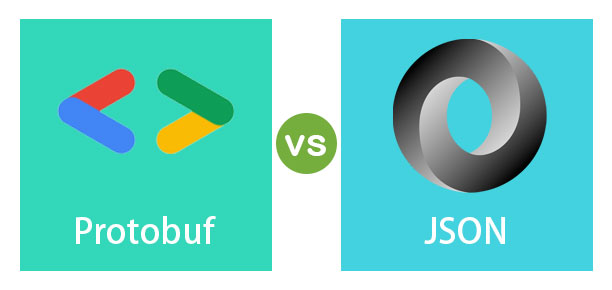Updated April 6, 2023
Difference Between Protobuf vs JSON
Protobuf is an acronym for Protocol buffers. Protobuf or Protocol buffer was designed by Google for serialization and de-serialization of structured data. It provides a better way of communication between different systems as it is simple, faster, and more manageable than XML. JSON stands for JavaScript Object Notation. It was derived from JavaScript but is not specific to one language. JSON is standardized and is supported by almost all languages. Protobuf vs JSON Both are for serialization; however, the key difference is that Protobuf is binary data –interchange format, whereas JSON stores data in human-readable text format.
Head to Head Comparison between Protobuf vs JSON (Infographics)
Below are the top 11 comparisons between Protobuf vs JSON:
Key differences between Protobuf vs JSON
Let us discuss some key differences between Protobuf vs JSON in the following points:
- Protobuf is a binary data-interchange format developed by Google, whereas JSON is the human-readable data-interchange format. JSON is derived from JavaScript but as the name suggests, it is not limited to JavaScript only. It was designed in such a way that it can be used in multiple languages
- Protobuf supports binary serialization format, whereas JSON is for simple text serialization format
- JSON is useful for common tasks and is limited to certain types of data. It means JSON cannot serialize and de-serialize every python object. Whereas Protobuf covers a wide variety of data types when compared to JSON. Even enumerations and methods can be serialized with Protobuf.
- Both Protocol buffers and JSON are languages interoperable, but Protobuf are limited to subsets of programming language, whereas JSON is widely accepted.
- JSON contains the only message and not schema, whereas Protobuf not only has messages but also includes a set of rules and schemas to define these messages.
- Protobuf is mostly useful for internal services whereas JSON is mostly useful for web applications.
- Prior knowledge of schema is essential in decoding Protobuf messages, whereas data can be easily decoded or parsed in JSON with knowing schemas in advance.
Example
Protobuf:
message employee_details {
required int32 employee_id = 1;
required string name = 2;
optional string address = 3;}
JSON data:
{
"employee_details" : { "name" : 'John Anderson', "employee id" : 2001, "address" : "California"}
}Comparison Table of Protobuf vs JSON
The table below summarizes the comparisons between Protobuf vs JSON:
| Protobuf |
JSON |
| Protobuf is an efficient way of encoding data and was developed by Google for serialization and de-serialization of structured data. | JSON stands for JavaScript Object Notation. JSON is a lightweight data-interchange format and was derived from JavaScript. |
| Protocol buffers are language-independent and platform-neutral encoding mechanism. | Although derived from JavaScript, JSON is language interoperable JSON is another way of storing python objects into a disk so that later on, it can be loaded without having the need to recreate the data again. |
| Protobuf is not just a message format, it also incorporates a set of rules to define and exchange messages. | JSON is simply a message format without having any schemas. |
| Protobuf messages are in binary format. These messages include not just the message but also the set of rules and tools to define and exchange these messages. | JSON messages are exchanged in a human-readable text format. |
| Protobuf though is language-neutral but currently is limited to only a few programming languages. For example, it is supported by JAVA, C, C++, Python, GO, ruby, but it is not supported by R. | JSON is supported by almost all the programming languages. JSON is language independent. So even a non Python programmer can use this for data interchange. |
| Protobuf schemas are associated with the data. | JSON stores data in text format and doesn’t have any schema associated with it. |
| Protobuf buffers are mostly useful for sending data between internal services. | JSON is mostly used in web applications where data exchange takes place between a browser and the server. |
| Protobuf supports more data types than JSON. | JSON is limited to certain python objects, and it cannot serialize every python object. |
| Protobuf supports a wider range of data types when compared to JSON. For example, enumerations and methods are supported by Protobuf and not supported by JSON. | JSON supports only a subset of python data types. Following data types:
Below data types are not supported by JSON:
|
| Protocol buffers are much faster than JSON. | JSON is lightweight and is faster than other serialization techniques like pickling. |
Advantages:
Disadvantages:
|
Advantages:
Disadvantages:
|
Conclusion
Here, we have seen two different and easy techniques to serialize data. Both have their own advantages and disadvantages. If the user is comfortable with the binary format he can go with Protocol buffers but if interoperability is the constraint for the user and wants a text format then he can use JSON module. It’s up to the programmer or the user to choose among them as per their need. However, it is advised not to de-serialize data from unknown sources as it may contain malicious and erroneous data.
Recommended Articles
This is a guide to the top differences between Protobuf vs JSON. Here we discuss the Protobuf vs JSON key differences with infographics and comparison table. You may also have a look at the following articles to learn more –




